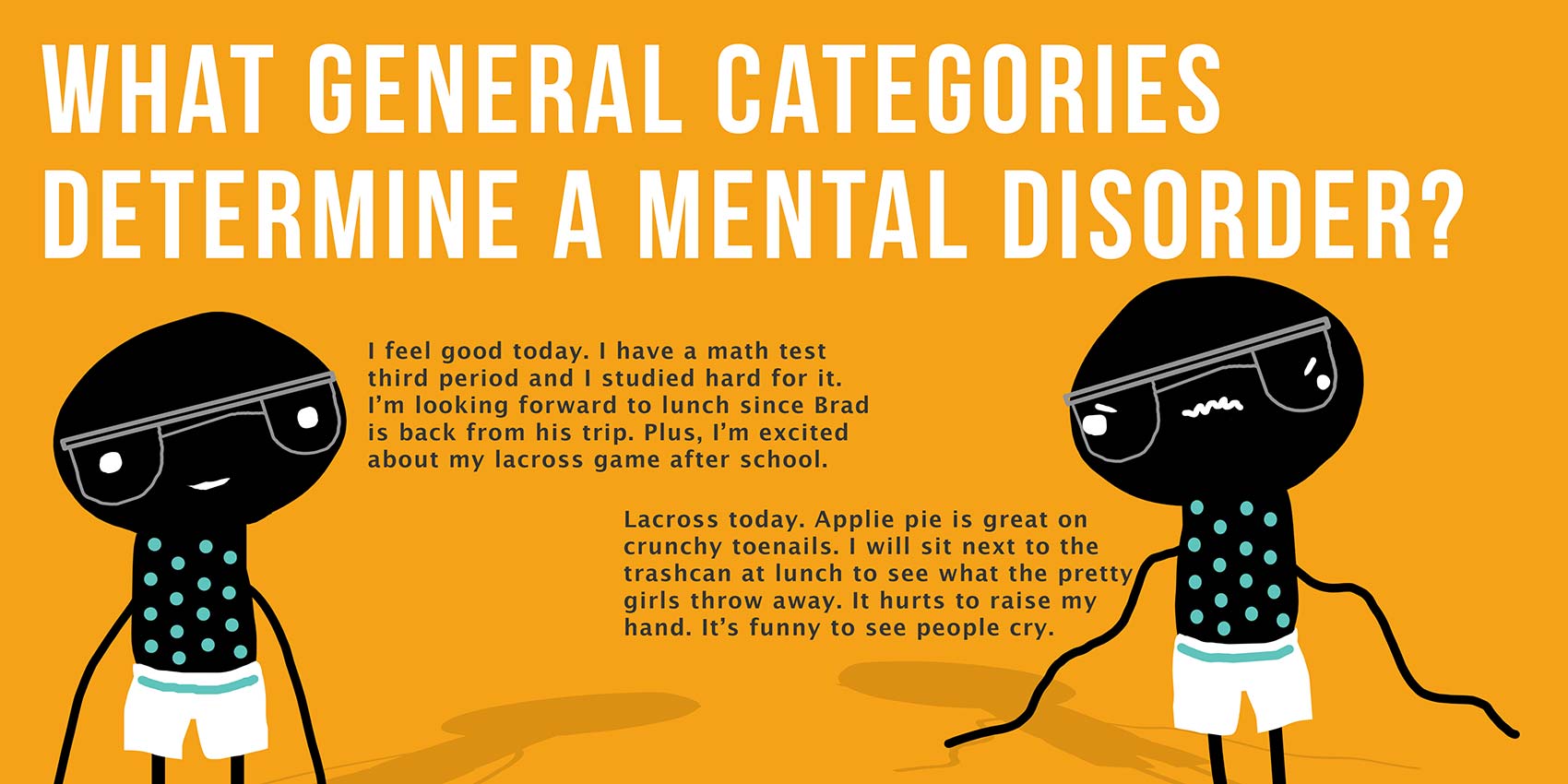27 Mar What general categories determine a mental disorder?

Skye to The Rescue…
Above are two pictures of Skye. Skye will show examples of mental disorders in these posts. Whenever you see Skye, you will see a list of thought patterns and behaviors that typically represent the mental disorder Skye is portraying (meaning showing/describing).
In the pictures above, Skye is showing you what mental health looks like on the left. Notice the thoughts are positive, logical and consistent. The sense of self is good and emotions are steady. Skye appears responsible, is dressed neatly and looks prepared for the day.
On the right, Skye represents someone who has a mental disorder. The sense of self is fragmented, thoughts are incoherent (meaning they do not follow logic and don’t connect well) and he is disheveled (meaning not very clean or well-groomed). Also, notice the thoughts are not based in reality. This is a sign of someone who has a psychosis. Psychosis is something you will read about in the next post.
Below is an outline of the six main categories we will use to describe someone’s mental health or illness. Skye will be in each of the following sub-posts depicting (meaning showing) some of the main features (but not all features) of the specific disorder discussed.
The Categories used to describe someone’s mental health or illness…
1. Sense of self: Is it consistent, inconsistent, fragmented, positive, negative? The sense of self is who you think you are. It is made up of your past experiences, your behaviors, thoughts, feelings, likes, dislikes, talents, weaknesses, morals, values and even your physical makeup. It is your identity, personality, character and qualities that make you distinct from everyone else.
2. Care of the physical self: Factors include: Cleanliness, consistently well-groomed, general concern about appearance and overall health. How you take care of yourself provides a glimpse of how you feel about yourself. Taking a shower, brushing hair, dressing neatly in clean clothes are all examples of taking care of yourself. These are important self-care behaviors.
3. Responsibility: Factors include: Showing up on time for appointments, ability to work, keep a job, be conscientious (meaning aware of what you need to do/appropriate behavior). How well you can navigate life’s responsibilities and behave in social and work situations are part of mental health. Becoming so overwhelmed by responsibilities or having an inability to comply with (follow) rules and norms is an indication of a potential mental disorder.
4. Thought patterns: Are they logical? Disconnected? Are thoughts based in reality? When a person begins to think things are happening that are not happening (like space creatures are dancing on your toothbrush), then a mental disorder is likely to blame. The inability to stay on topic (I want to go to the store. It will be nice to have a swim there.), can be a sign of a mental disorder as well.
5. Emotions: Factors include: Easily upset or calm and centered? Moody? A largely negative affect (affect is the outward display of internal mood) or one that swings between extremes? It is normal to feel bombarded by emotions, but when they are so overwhelming that they cause serious distress or impair someone’s ability to function, then mental health issues are a consideration.
6. Relationships with others: Factors include: The ability to form steady relationships, to trust, receive love, and care for others. Many relationships come and go in life and that’s normal. But when a person can’t seem to maintain any relationships/friendships and they end in a dramatic fashion (think yelling, screaming and a person’s wardrobe being set on fire in a pile on the front lawn), then a warning sign of mental health has been raised.
Don’t Panic… (This is just an overview)
Please note that the above six categories are general outlines. The following posts will walk you through the main themes of mental disorders, but you do not need to worry about knowing all of these categories. What matters is gaining a general understanding of the difference between what is “normal” and what is a disorder. You can see from the two representations of Skye above, that being psychotic is very, very different than being a normal, healthy teen.
Of particular concern here is that the teen years can feel uncomfortable at times and perhaps make you question your own sanity. That is completely normal! But there is a difference between what you are going through during the teen years versus what is considered clinically significant or pathological (meaning caused by or involving a mentally disturbed condition).
A New Normal?…
The teen years feel crazy at times – this is normal.
Your sense of self is changing – this is normal.
Your emotions are running all over the place – totally normal!
You may feel like not showering for a few days and wearing sweats for a week – that’s normal!
You may have negative thoughts about your friends, your family and even your self. Yes, totally normal during the teen years.
Just keep in mind that if your thoughts or behaviors feel negative and last more than a couple weeks, then you may want to bring it to someone’s attention. You will read more about this soon.




WLKHS1313
Posted at 13:02h, 11 Octoberyes it helps me see the different factors of a mental illness and how serious mental health is to people and how it should be taken seriously and not as a joke. i think that my mental health is in the middle because i do not know how to control my emotions.